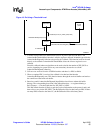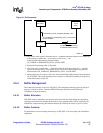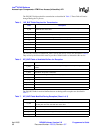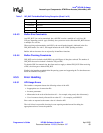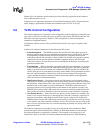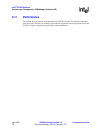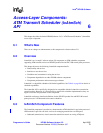
Intel
®
IXP400 Software
Access-Layer Components: ATM Manager (IxAtmm) API
Programmer’s Guide IXP400 Software Version 2.0 April 2005
Document Number: 252539, Revision: 007 73
5.5 ATM-Port Management Service Model
IxAtmm can be considered an “ATM-port management authority.” It does not directly perform data
movement, although it does control the ordering of cell transmission through the supply of ATM
cell-scheduling information to the lower levels.
IxAtmm manages the usage of registered ATM ports and will allow or disallow a VC to be
established on these ports — depending on existing active-traffic contracts and the current
upstream port rate.
Once a connection is established, a client can begin to use it. The client makes data transfer
requests directly to corresponding AAL layer through the IxAtmdAcc component. The AAL layer
passes the request to the IXP4XX product line and IXC1100 control plane processors though the
appropriate hardware layers, under direction from IxAtmm.
The IxAtmm service model consists of two basic concepts:
• ATM port
• VC/VCC (virtual channel/virtual channel connection) connections that are established over
this port
A VC is a virtual channel through a port. A VC is unidirectional and is associated with a unique
VPI/VCI value. Two VCs — in opposite direction on the same port — can share the same VPI/VCI
value. A VCC is an end-to-end connection through linked VCs, from the local ATM port to another
device across the ATM network.
Initially, a port is “bare” or “empty.” A VC must be attached (registered) to a port. Registration
means, “to let IxAtmm know that — from now on — that the VC can be considered usable on this
port.”
IxAtmm is not responsible for signaling and obtaining admission from the network for a VCC. A
client needs to use other means, where necessary, to obtain network admission of a VCC. A client
specifies to IxAtmm the traffic descriptor for the requested VCC. IxAtmm will accept or deny this
request based only on the port rate available and the current usage of the port by VCCs already
registered with the system. This CAC functionality is provided by the IxAtmSch component.
IxAtmm presumes that the client has already negotiated — or will negotiate — admission of the
VCC with the network.



